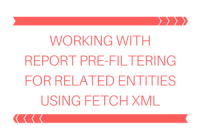Obtain OrganizationService using Application User in Dynamics 365
Introduction: The Application User is the concept that allows us (developers) programmatic access to Dynamics 365 data and entities. Prior to the introduction of Application User concept we were using licensed user account’s User Name and Password to authenticate to CRM and perform operations. As a developer, you may have come across with the situation… Read More »


